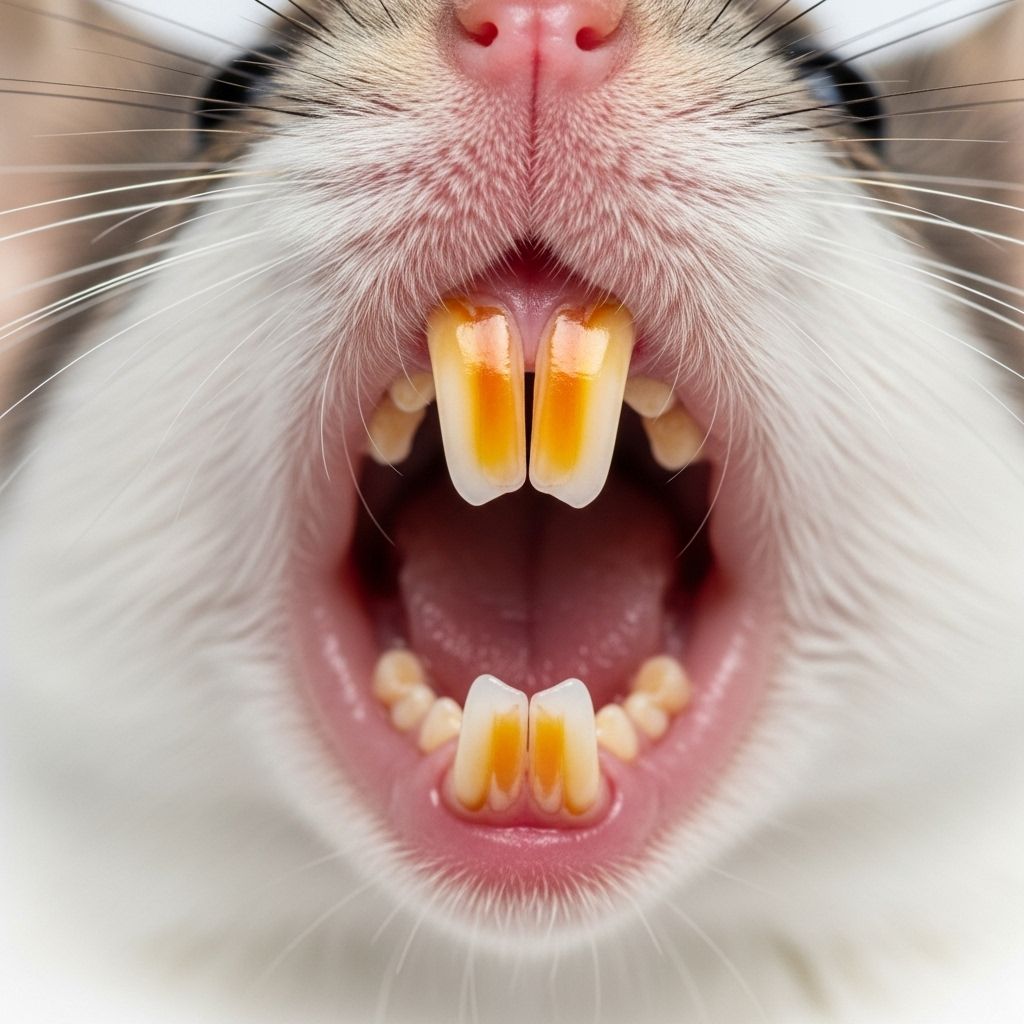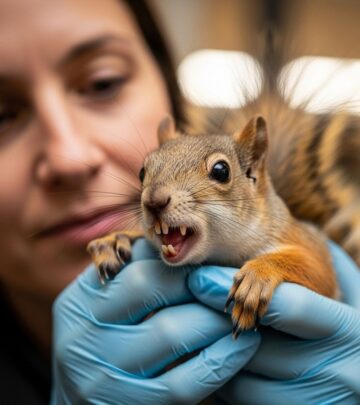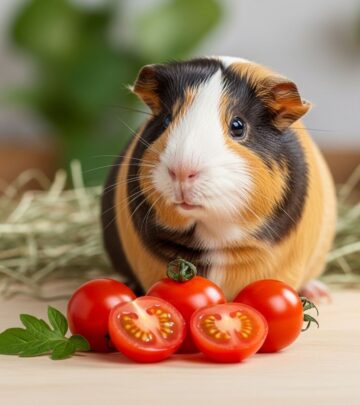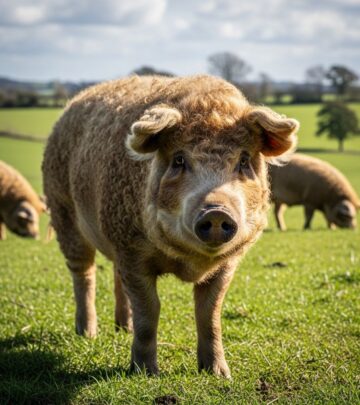Mouse Teeth: Structure, Growth, and Dental Care Essentials
Proper gnawing outlets prevent overgrowth and support your small companion’s wellbeing.

Understanding the dental health of your pet mouse is crucial for its wellbeing. Mice, like all rodents, have unique teeth that grow continuously throughout their life. Proper care and vigilance are necessary to prevent dental issues that can profoundly impact a mouse’s health and quality of life. This guide covers the anatomy of mouse teeth, reasons for their perpetual growth, common dental problems, prevention strategies, and tips for home dental care.
Mouse Dental Anatomy
Every mouse has a simple yet fascinating arrangement of teeth, perfectly adapted to their gnawing lifestyle. Their dentition is specialized for a life of constant chewing and grinding.
Types of Mouse Teeth
- Incisors: Mice possess four incisors: two on the upper jaw (maxillary), and two on the lower jaw (mandibular). These are large, chisel-shaped teeth at the very front of the mouth and are the most visible feature of their smile.
- Molars: Behind the gap (called the diastema), mice have molars — grinding teeth that process food. There are three molars on each side of the upper and lower jaws.
- No Canines or Premolars: Mice do not have canine teeth or premolars. The gap between incisors and molars is the diastema, which is a distinguishing feature of rodent dentistry.
The dental formula for a mouse is:
1/1 (incisors), 0/0 (canines), 0/0 (premolars), 3/3 (molars), for a total of 16 teeth.
Unique Features
- Open-rooted or Rootless Incisors: Mouse incisors are termed open-rooted or hypselodont, meaning they do not have roots. Their pulp canals remain open, which enables continuous growth.
- Color and Hardness: The front surface of the incisors is covered in tough, pigmented enamel, which can sometimes appear yellowish or orange (in some rodent species) due to iron compounds. The back side is softer dentin, aiding in the self-sharpening mechanism.
Why Do Mouse Teeth Grow Continuously?
Continuous dental growth is one of the defining characteristics of rodents. Unlike human teeth, which stop growing after erupting, mouse incisors lengthen throughout life. Molars, however, do not grow continuously in mice. This adaptation supports a gnawing lifestyle, as mice use their incisors to chew through hard objects, seeds, grains, and wood.
Mechanics of Growth
- The incisors grow at an average rate of 1 to 2 mm per week.
- This rapid growth compensates for the wear incurred from gnawing, keeping the teeth at an ideal length.
- If a mouse cannot wear down its teeth naturally (due to diet, genetics, or injury), the incisors can become excessively long, leading to serious health problems.
Self-Sharpening Mechanism
- Enamel and Dentin Structure: The hard enamel is only present on the front (labial) side of the incisor, while the back (lingual) side is made of softer dentin.
- Result: As mice gnaw, the dentin wears away faster than the enamel, creating the characteristic chisel shape that is self-sharpening and permanently sharp.
Common Dental Problems in Mice
Dental issues in mice are not only painful for the animal but can also affect their ability to eat, resulting in weight loss or secondary infections. Recognizing and addressing dental problems early is key to ensuring your mouse’s health.
Symptoms of Dental Issues
- Visible overgrown incisors projecting out of the mouth or curling inwards
- Difficulty eating, dropping food, or a preference only for soft foods
- Weight loss or failure to thrive
- Salivation, wet fur around the mouth or chin
- Facial swelling or visible abscesses
- Decreased activity or signs of pain
- Runny eyes due to root overgrowth pressing on tear ducts
Causes of Dental Problems
- Genetic Factors: Some mice are predisposed to malocclusions (misalignment) because of jaw or tooth shape inherited from their parents.
- Diet: Soft diets that do not provide enough abrasive material fail to wear down incisors adequately.
- Trauma or Injury: A broken incisor or jaw injury can lead to uneven tooth growth and misalignment.
Types of Issues
| Condition | Description |
|---|---|
| Malocclusion | Teeth do not meet correctly, leading to uneven tooth wear and eventually, difficulty eating or injuries inside the mouth. |
| Overgrown Incisors | Incisors that have grown too long; they may puncture soft tissue, prevent mouth closure, or impede eating. |
| Abscesses | Infections from untreated dental injuries can form painful swellings or pus pockets in the jaw. |
| Broken Teeth | Teeth can snap due to trauma or improper chewing, exposing nerves or leading to uneven regrowth. |
How To Prevent Dental Problems in Mice
The majority of mouse dental issues are preventable with attentive care and dietary management. Owners play an active role in their pet’s dental health and should incorporate preventive measures into regular care routines.
Provide Appropriate Chew Items
- Offer hard, safe materials for gnawing, such as untreated wood blocks, cardboard tubes, and commercially available rodent chew toys.
- Rotate chew items regularly to maintain interest.
- Avoid materials that could splinter or contain toxic substances.
Dietary Considerations
- Ensure the staple diet consists of high-quality rodent blocks or laboratory pellets. These are designed to wear down teeth naturally as mice gnaw them.
- Supplement with crunchy vegetables (carrots, broccoli stems) and limited amounts of seeds or grains that encourage natural chewing behaviors.
- Avoid exclusively soft or sticky foods, as they do not facilitate abrasion and may lead to plaque buildup.
Environmental Enrichment
- Add cardboard tubes, tunnels, or platforms to the cage to stimulate chewing activity.
- Ensure ample bedding and foraging opportunities, prompting natural exploratory and gnawing instincts.
What To Do If Your Mouse Has Dental Problems
If you notice signs of dental issues in your mouse, act promptly to avoid complications. Dental problems require swift assessment and possible intervention by a veterinarian experienced with rodents.
Seeking Veterinary Assistance
- Contact an exotics or rodent-savvy veterinarian if you observe overgrown, misaligned, or broken teeth, or notice changes in eating and behavior.
- The veterinarian may trim or file overgrown incisors, remove abscesses, or treat infections.
- Do not attempt to trim teeth at home unless specifically guided by a professional; improper handling can lead to fractures or painful injuries.
At-Home Monitoring and Care
- Watch for returning symptoms even after treatment, as some mice are prone to chronic dental issues.
- Maintain a proper diet and environmental enrichment as outlined above.
- Weigh your pet weekly; slow or sudden weight loss may indicate the recurrence of dental problems or inadequate food intake.
Understanding Mouse Tooth Growth: Scientific Insights
Recent research has mapped out the fine-scale cellular composition and regeneration patterns of mouse teeth. Unlike human teeth, where growth eventually stops, mouse incisors rely on a highly specialized population of stem and progenitor cells clustered in the base (apex) of each tooth. These cells are responsible for the ongoing growth of dental tissue throughout the rodent’s life.
- The pulp of the mouse incisor is a dynamic site of regeneration and repair, especially after injury.
- Stem cells in the tooth respond rapidly to physical damage, supporting both regrowth and self-renewal cycles.
- Differences exist between growing mouse incisors and non-growing molars, which explains why only the incisors require regular wear for overall oral health.
Comparing Mouse Teeth to Other Rodents
Mice share their basic dental plan with all rodents, a diverse group that includes rats, rabbits, guinea pigs, and beavers. Some key similarities and fascinating distinctions are worth noting:
- Rodent incisors (in all species) are chisel-shaped, continually growing, and lack roots. Only the front surface has enamel.
- All rodents rely heavily on gnawing not only for food processing but also for self-defense and nest building.
- Some rodents, like rabbits and guinea pigs, have additional pairs of incisors, but the need for abrasive chewing material is universal.
Frequently Asked Questions (FAQs)
Q: How fast do mouse incisors grow?
A: Typically, mouse incisors grow about 1–2 mm per week, requiring continuous gnawing to prevent overgrowth.
Q: Can I trim my mouse’s teeth myself?
A: No, teeth trimming should only be performed by a veterinarian. DIY trimming is risky and can cause pain, fractures, or infections.
Q: What materials are safe for my mouse to chew?
A: Safe items include untreated wood blocks, cardboard tubes, and rodent chew toys. Avoid painted, chemically treated, or splinter-prone materials.
Q: My mouse is losing weight—could it be dental problems?
A: Yes, dental overgrowth or misalignment often leads to eating difficulty and weight loss. Prompt veterinary assessment is recommended.
Q: Are dental problems common in older mice?
A: Dental issues can occur at any age, but older mice may be more prone due to accumulated wear, jaw injuries, or changes in feeding behavior.
Conclusion: Keeping Your Mouse’s Teeth Healthy
Maintaining proper tooth wear is essential for a mouse’s health and happiness. By providing a balanced diet, appropriate chew materials, and regular monitoring, you can prevent most dental issues and ensure your pet enjoys a pain-free life.
Always work with an experienced exotics veterinarian for any dental problems, and observe your mouse’s eating habits and appearance for early signs of trouble. Healthy teeth make for a healthy mouse!
References
- https://www.nature.com/articles/s41467-020-18512-7
- https://www.nature.com/articles/laban0107-22
- https://vivo.colostate.edu/hbooks/pathphys/digestion/pregastric/rodentpage.html
- https://mckinneysmiles.com/great-example-dental-variety-animal-kingdom/
- https://anatomypubs.onlinelibrary.wiley.com/doi/abs/10.1002/(SICI)1097-0185(199803)250:3%3C268::AID-AR2%3E3.0.CO;2-X
- https://www.facebase.org/chaise/record/
- https://ert-test.latech.edu/mouse-teeth
Read full bio of medha deb












